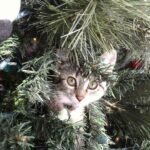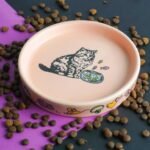Your cat deserves the best nutrition possible, but even premium dry food can lose its nutritional value and become unsafe if not stored properly. We’ve all been there, opening a bag of kibble only to find it smells off or discovering those dreaded pantry moths floating around our pet supplies. The good news? Learning how to keep dry cat food fresh is easier than you might think, and it can save you money while keeping your feline friend healthy and happy.
Proper food storage isn’t just about maintaining flavor, it’s about preserving essential nutrients, preventing contamination, and ensuring your cat’s safety. When dry cat food loses its freshness, it doesn’t just become unappetizing; it can actually become harmful to your pet’s health.
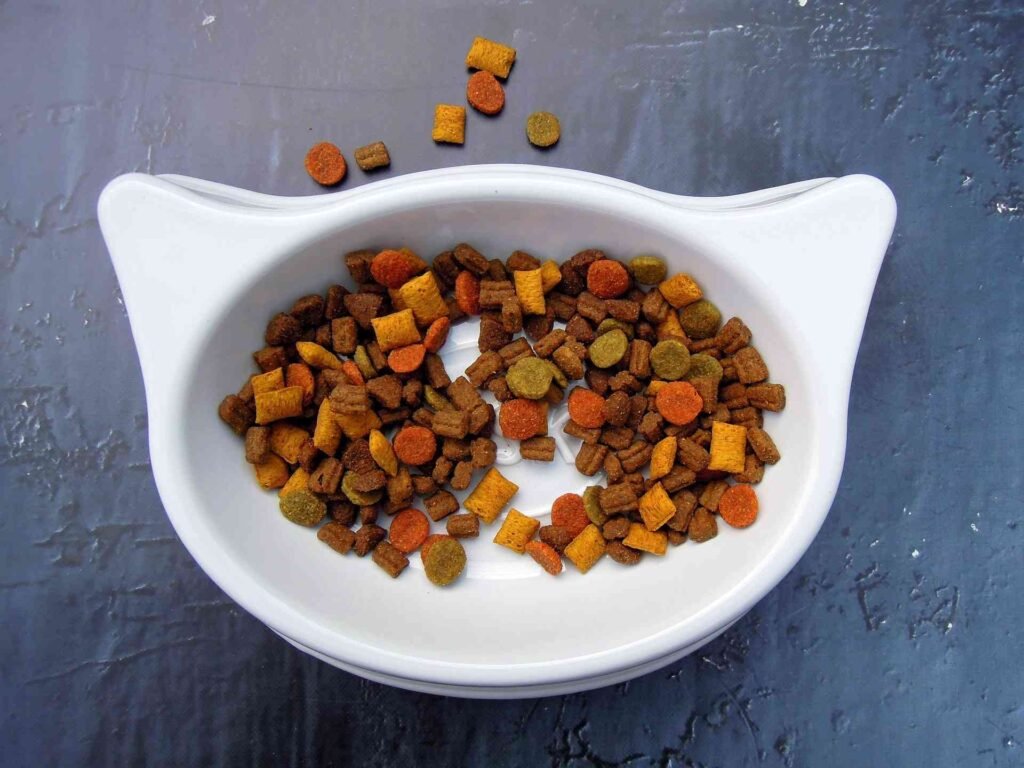
Why Proper Dry Cat Food Storage Matters
Fresh cat food means better nutrition absorption, improved digestion, and a happier, healthier cat. When kibble sits exposed to air, light, and moisture, several concerning things happen. The fats in the food begin to oxidize, creating rancid flavors that cats instinctively avoid. Vitamins break down over time, especially fat-soluble vitamins A, D, E, and K that are crucial for your cat’s well-being.
More seriously, improperly stored food becomes a breeding ground for bacteria, mold, and insects. We’ve seen countless cases where well-meaning cat parents unknowingly fed their pets contaminated food simply because they didn’t understand proper storage techniques. The result? Upset stomachs, food poisoning, and expensive veterinary bills that could have been easily avoided.
How often you clean your cat’s food and water bowls also plays a role in maintaining food freshness, as residual oils from old kibble can accelerate spoilage of fresh food.
Dry Cat Food Expiration
Before diving into storage methods, it’s important to understand how long you can store dry cat food safely. Unopened bags typically maintain peak quality for 12-18 months from the manufacturing date when stored properly. However, once opened, the clock starts ticking much faster.
Most dry cat foods should be consumed within 6 weeks of opening for optimal freshness and safety. This timeline can vary based on the food’s fat content, preservatives used, and storage conditions. Foods with higher fat content or natural preservatives tend to have shorter lifespans once exposed to air.
The “best by” date on pet food packaging indicates peak quality rather than safety, but it’s still a valuable guideline. Always check this date before purchasing, and choose bags with the latest dates when possible. Buying smaller bags more frequently often results in fresher food than purchasing bulk quantities that sit around for months.
How to Store Dry Cat Food After Opening
The moment you open that fresh bag of kibble, proper storage becomes critical. The original packaging, while convenient for transport and display, isn’t designed for long-term storage once opened. Most pet food bags have minimal barrier properties against air and moisture once the seal is broken.
Your first line of defense is keeping the food in a cool, dry place away from direct sunlight. Temperature fluctuations and humidity are enemies of food freshness. Ideally, storage areas should maintain temperatures below 80°F with low humidity levels.
Many cat owners make the mistake of transferring kibble immediately into storage containers without considering the original packaging. The inner lining of quality pet food bags often contains important barrier properties that help preserve freshness. When possible, place the entire unopened bag inside your storage container rather than pouring the food directly into it.
Essential Storage Equipment and Containers
Choosing the right storage container can make or break your food preservation efforts. Airtight containers are absolutely essential, any exposure to air accelerates the breakdown of fats and nutrients. Look for containers with tight-fitting lids and rubber gaskets that create a complete seal.
Food-grade plastic containers work well for most situations, but avoid containers that previously held non-food items, as they may retain odors or harmful residues. Stainless steel and glass containers offer excellent protection against pests and are easy to clean, though they’re typically more expensive.
Size matters when selecting containers. Choose containers that can accommodate your typical bag size with minimal air space remaining. Too much empty space means more air contact, which speeds deterioration. For households with multiple cats or those who buy larger bags, consider dividing food into smaller portions using multiple containers.
Here’s a comparison of popular storage container materials:
| Material | Example (Amazon) | Pros | Cons | Best For |
|---|---|---|---|---|
| Food-Grade Plastic | Gamma2 Vittles Vault | Lightweight, affordable, variety of sizes | Can retain odors over time, may scratch | Most households, budget-conscious |
| Stainless Steel | simplehuman 40 lb | Easy to clean, pest-resistant, odor-free | Higher cost, heavier | Long-term use, multiple pets |
| Glass | Aloxina Treat Container | Non-porous, easy to clean, see-through | Heavy, breakable, expensive | Small quantities, indoor storage |
| Ceramic | ALYC White Ceramic | Attractive, odor-resistant, easy to clean | Heavy, breakable, limited sizes | Countertop storage, small amounts |
Don’t forget about measuring cups and scoops. Having dedicated tools for pet food prevents cross-contamination from human food preparation and helps maintain consistent portions. Knowing your cat’s treat schedule can also help you plan storage needs for both main meals and snacks.
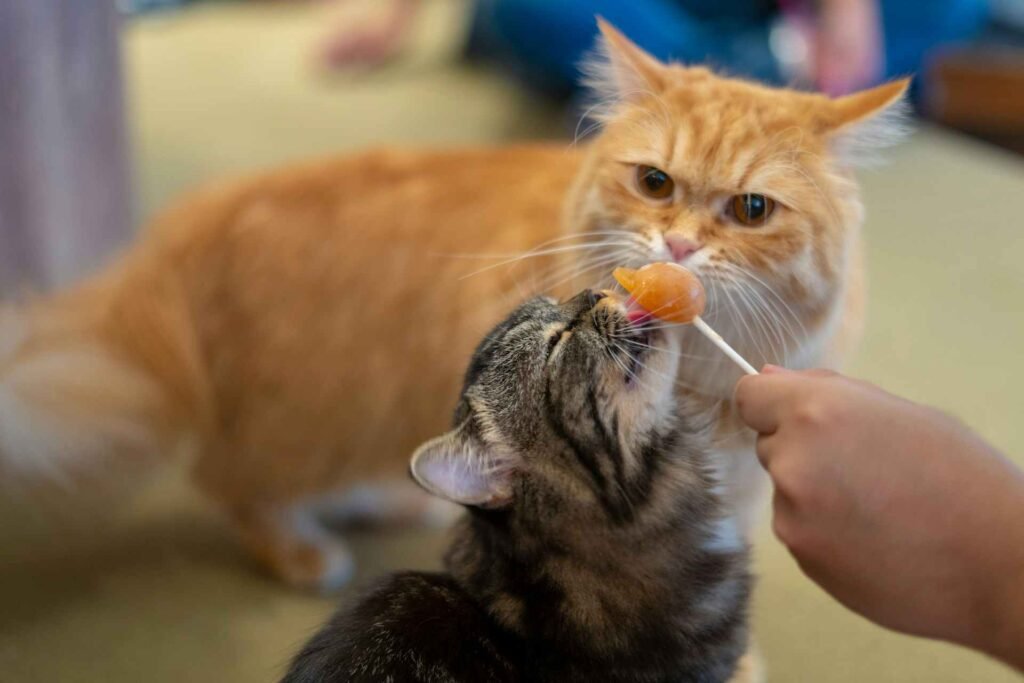
How to Store Dry Cat Food Long Term
Long-term storage requires extra planning and preparation. If you’re buying in bulk or want to stock up during sales, proper technique becomes even more crucial. The key is minimizing exposure to the elements that cause deterioration: air, light, moisture, and temperature fluctuations.
Consider dividing large quantities into smaller, meal-sized portions. This approach limits air exposure to unused portions while you work through your current supply. Vacuum-sealed bags work exceptionally well for this purpose, removing virtually all air contact.
For extended storage, freezing is an option, though it requires careful planning. Frozen dry cat food can maintain quality for several months, but it must be completely sealed to prevent freezer burn and moisture absorption. Allow frozen food to return to room temperature and check for condensation before serving.
Climate-controlled storage areas are ideal for long-term food preservation. Basements, pantries, or dedicated storage rooms that maintain consistent temperatures work better than garages, sheds, or areas near heating and cooling vents where temperature swings are common.
Common Storage Mistakes That Compromise Freshness
Even well intentioned cat owners often make storage errors that reduce food quality and safety. One of the most common mistakes is leaving food in opened original bags without additional protection. These bags aren’t designed to maintain freshness once opened, and clips or twist ties don’t provide adequate sealing.
Storing food in warm areas like garages, laundry rooms, or near heat sources accelerates spoilage dramatically. We’ve seen cases where food stored in hot garages developed rancid odors within days of opening. Similarly, humid environments like basements without proper climate control can promote mold growth.
Another frequent error is mixing old and new food without proper rotation. This practice, known as “topping off,” can contaminate fresh food with older, potentially spoiled kibble. Always use older food first and thoroughly clean containers between batches.
Keeping ants away from cat food is another common challenge that proper storage helps prevent. Airtight containers eliminate the scent trails that attract insects to pet food.
Over-purchasing is a mistake many bulk-buyers make. While buying larger quantities can save money, it’s counterproductive if food spoils before consumption. Calculate your cat’s actual consumption rate and purchase accordingly. Preventing cats from eating too fast can help ensure accurate portion calculations and reduce waste.
Signs Your Cat Food Has Gone Bad
Recognizing spoiled cat food protects your pet’s health and prevents waste. Fresh dry cat food should have a neutral, slightly grain-like smell. Any sour, rancid, or musty odors indicate spoilage. Trust your nose, if something smells off, don’t risk feeding it to your cat.
Visual inspection reveals many problems. Look for any discoloration, visible mold, or unusual spots on the kibble. Mold appears as fuzzy growths and can be white, green, blue, or black. Even small amounts of mold contaminate entire batches and pose serious health risks.
Texture changes also signal problems. Fresh kibble should feel dry and maintain its shape. Soft, soggy, or crumbly pieces indicate moisture exposure that can lead to bacterial growth. Any signs of insect activity, live bugs, larvae, or webbing, mean immediate disposal is necessary.
Your cat’s behavior provides valuable feedback too. Cats have excellent senses of smell and taste, often refusing food that’s beginning to spoil before humans notice problems. If your normally enthusiastic eater suddenly becomes picky, examine the food carefully.
Seasonal Storage Considerations
Different seasons present unique storage challenges that require adjusted strategies. Summer heat and humidity create ideal conditions for bacterial growth and insect activity. During hot months, pay extra attention to storage temperatures and consider relocating food to cooler areas.
Winter heating systems can create dry conditions that, while inhibiting mold growth, may make food more prone to rancidity through increased air circulation. Sealed containers become even more important during heating season when indoor air circulation increases.
Spring and fall temperature fluctuations can cause condensation issues in storage containers. If you notice moisture inside containers, immediately transfer food to dry storage and ensure containers are completely dry before refilling.
Feeding community cats can affect outdoor storage, as even more attention must be paid to temperature and weather protection.
Special Considerations for Multi-Cat Households
Households with multiple cats face unique storage challenges, primarily around quantity management and dietary differences. Different cats may require different foods due to age, health conditions, or preferences, requiring separate storage systems.
Larger households typically purchase bigger quantities, making proper rotation and freshness monitoring more critical. Consider dating containers when filling them and using a first-in, first-out system to ensure optimal freshness.
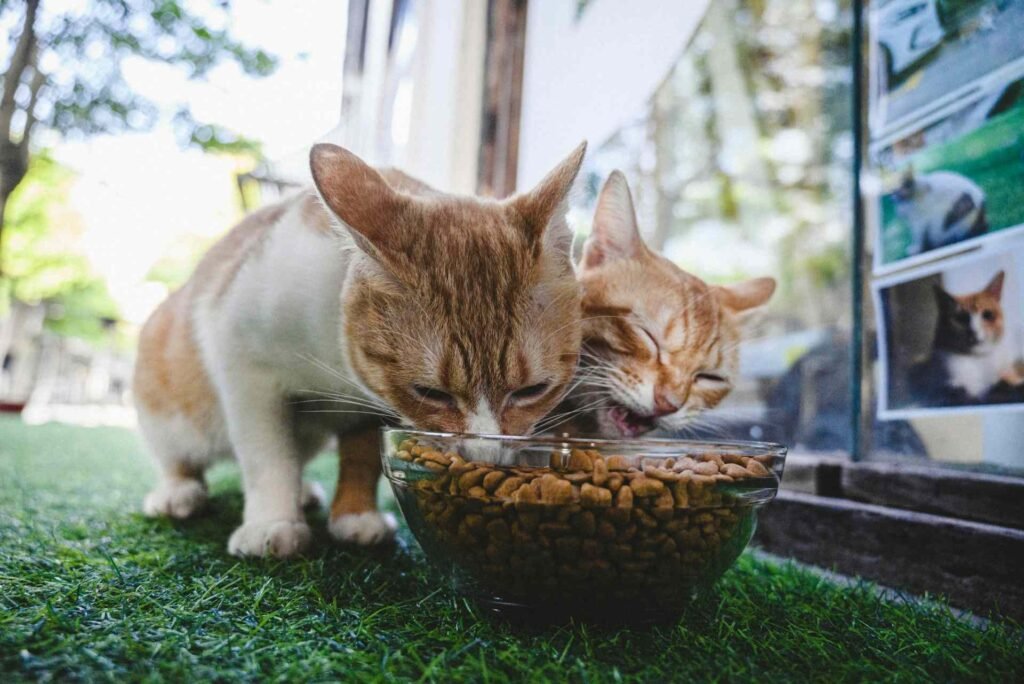
Keeping cats entertained while at work might include puzzle feeders or timed feeders that require careful food portioning and storage planning. These systems work best with properly stored, fresh food that maintains its appeal throughout the day.
Creating a Food Storage System That Works
Developing a consistent storage routine makes freshness maintenance easier and more reliable. Start by designating specific storage areas and containers for cat food. Consistency helps prevent mistakes and makes monitoring easier.
Create a simple tracking system for monitoring food age and rotation. This can be as simple as writing opening dates on containers with permanent markers or keeping a small notebook near storage areas. The goal is making freshness monitoring effortless and automatic.
Consider the convenience factor in your system design. Storage solutions that are difficult to use or access often get abandoned over time. The best system is one that you’ll actually follow consistently.
Water fountain maintenance requires similar attention to cleanliness and freshness as food storage, creating a complete nutrition and hydration system for your cats.
Frequently Asked Questions
How long does dry cat food last once opened?
Most dry cat food maintains optimal quality for 4-6 weeks after opening when stored properly in airtight containers in cool, dry conditions. However, this timeframe can vary based on the food’s fat content, preservatives, and storage environment. Foods with higher fat content may spoil faster, while those with synthetic preservatives may last slightly longer.
Can you freeze dry cat food to extend its life?
Yes, dry cat food can be frozen to extend its shelf life, potentially maintaining quality for several months. However, freezing requires proper preparation including airtight packaging to prevent freezer burn and moisture absorption. Allow frozen food to return to room temperature completely and check for condensation before serving to your cat.
Should you wash cat food storage containers?
Absolutely. Food storage containers should be thoroughly washed and completely dried between batches to prevent bacterial growth and rancid oil buildup. Even small residues from old food can contaminate fresh kibble and accelerate spoilage. Use warm, soapy water and ensure containers are completely dry before refilling.
Is it better to store cat food in the original bag or transfer to containers?
The ideal approach combines both methods: place the unopened original bag inside an airtight container. This preserves the bag’s barrier properties while adding extra protection against air, moisture, and pests. If you must transfer food directly, do so quickly to minimize air exposure, and ensure containers are completely clean and dry.
What temperature is best for storing dry cat food?
Dry cat food should be stored at temperatures below 80°F (27°C) in low-humidity environments. Consistent temperatures work better than fluctuating conditions. Avoid storage areas near heat sources, in garages, or other spaces where temperatures vary significantly throughout the day.
How can you tell if dry cat food has gone rancid?
Rancid dry cat food develops a distinct sour or off-putting smell quite different from the normal grain-like odor of fresh kibble. You may also notice your cat refusing food they previously enjoyed, as cats can detect rancidity before humans. Visual signs include discoloration, oil spots, or any unusual appearance changes in the kibble.
Conclusion
Keeping your cat’s dry food fresh doesn’t require a degree in food science, just some basic knowledge and good habits. Think of proper storage as an investment in your cat’s health that pays dividends through better nutrition, fewer health issues, and less wasted food (and money!). Your feline friend might not thank you in words, but their enthusiastic mealtime purrs and continued good health speak volumes.
Cats are creatures of habit who appreciate consistency in their meals. By maintaining fresh, properly stored food, you’re not just preserving nutrients, you’re ensuring every meal meets your cat’s high standards. After all, we’ve never met a cat who didn’t have opinions about their food, and fresh food gets far better reviews than stale kibble.
The small effort you put into proper storage today prevents bigger headaches tomorrow. Your future self (and your cat) will appreciate having a reliable system that keeps food fresh, safe, and delicious meal after meal.
Looking for more? Explore our Cat Food section for more posts like this, visit the Blog for fun and insightful reads, or browse our full Cat Category for everything feline-related, from care to comfort.
Disclaimer: This article is for informational purposes only and does not substitute for professional veterinary advice. Always consult your veterinarian for diagnosis and treatment tailored to your cat’s individual needs. Please verify current product information directly on the retailer’s site before purchasing.
References
- How To Handle And Store Pet Food. https://www.petfoodinstitute.org/how-to-handle-and-store-pet-food/
Check out our most recent articles!
- Cats and Snow: Why Some Love It and Others Don’tSnow isn’t just uncomfortable for many cats, it’s a complete sensory overload. From cold paw pads to wet fur and changed landscapes, winter challenges feline comfort in unexpected ways. Learn how to recognize stress signals and create cozy alternatives for snow-averse cats.
- Christmas Names for Cats: From Classic to Creative Holiday IdeasNaming your holiday cat goes beyond festive fun. Discover why Christmas-inspired names age beautifully, spark instant connections with fellow pet lovers, and capture the warmth cats bring to our homes during the most magical season of the year.
- How to Keep Your Cat From Drinking Christmas Tree WaterYour cat’s obsession with Christmas tree water isn’t just annoying, it’s genuinely dangerous. From harmful bacteria to toxic additives, that festive reservoir poses real health risks. Discover practical solutions that protect your pet without sacrificing holiday cheer.
- Best Cat Toys for Christmas: The Ultimate Guide to Holiday JoyNot all Christmas gifts end up under the tree, some get batted across the floor at 3 AM. Explore the wonderful world of holiday cat toys that match your feline’s personality, from plush companions for cuddlers to high-tech options for the eternally energetic.
- Are Fake Christmas Trees Safe for Cats? A Holiday Safety GuideThat beautiful Christmas tree might look festive to you, but to your cat, it’s an irresistible climbing gym with built-in toys. Find out whether artificial trees are truly safer for cats and discover the hidden dangers lurking in your holiday decorations.
- The Best Christmas Gifts for Cats That’ll Actually Get Used (Not Ignored)Not all Christmas gifts land on the nice list with our feline friends. Discover which presents actually spark joy in cats and which ones end up gathering dust under the couch by New Year’s Day.
- Do Cats Eat Less in Winter? How Cold Weather Affects Your Cat’s AppetiteWinter brings more than just cold weather, it can completely change your cat’s eating habits. From bored indoor cats to outdoor ferals fighting to survive, discover what’s really driving those appetite changes and how to respond appropriately.
- Are Humidifiers Good for Cats? A Complete Safety & Health GuideNot all humidifiers are cat-safe, and some common practices could be toxic. Learn why cool mist beats warm mist, why essential oils are dangerous for felines, and how proper humidity levels between 30-50% support your cat’s breathing and coat health.
- How to Protect Leather Furniture From Cats (Without Losing Your Mind)Leather furniture and cat claws seem like natural enemies, but they don’t have to be. Learn why your cat is drawn to that expensive couch in the first place, and how simple redirects can save your furniture while keeping your cat’s natural behaviors satisfied.
- The Best Material for Cat Bowls: Protect Your Cat from BacteriaStainless steel, ceramic, or plastic, which material keeps your cat healthiest? We break down the science behind cat bowl materials, revealing why some harbor bacteria and others last decades without compromising your feline’s wellbeing.





